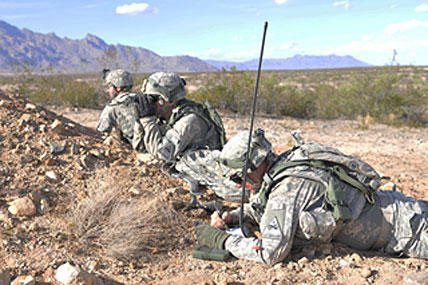Lawmakers on Capitol Hill plan to hack tens of millions of dollars from the Army's top modernization efforts, a move that would cut the service's network testing budget in half.
The Senate Appropriations Committee wants to cut $93.7 million of what it calls "excessive costs" from the Army's Network Integration Evaluation program's $193.7 million budget for fiscal 2013-2014. Other cuts include a $169 million reduction from the service's Ground Combat Vehicle program.
The proposed cuts are the result of the across-the-board belt tightening brought on by the mandatory defense cuts of sequestration.
The NIE is run twice a year at White Sands Missile Range, N.M., and Fort Bliss, Texas. Soldiers with 2nd Brigade, 1st Armored Division, test different components of the Army Network ranging from smartphones to command and control networks.
Army leaders stood up the evaluation three years ago to test and develop the service's new battlefield radios – the service's top modernization priority. The service has since held the NIE up as an acquisition success story following the 2009 cancellation of Future Combat Systems, a $160 billion program which included the radio network.
The Army has completed five NIEs and has reaped both technological and doctrinal benefits from the events, Army spokesman Matthew Bourke said in response to the report.
"As Army and budget priorities mature into FY15 and beyond, NIEs may look different, but they will remain a key venue to integrate network systems and obtain soldier feedback prior to fielding," he said. "The Army is using NIE 14.1 -- scheduled to take place October/November -- as a shaping action to continue to make the NIE process more efficient."
Army officials estimate that the NIE has already saved $6 billion by canceling under-performing programs such as the Unattended Ground Sensors and the Class 1 Unmanned Air System.
But lawmakers maintain that the NIE has not produced the program successes that the Army has promised.
"As confirmed in a Government Accountability Office August 2013 report assessing the NIE, the Committee is not aware of significant successful technology transitions of the over 100 systems evaluated at the NIE to date, despite additional funds having been provided by Congress specifically for that purpose," according to the SAC report. "Given the fiscal constraints the Army is facing, the committee questions the return on investment for NIE in its current form."
The committee's report also recommends cutting $106 million from the Warfighter Information Network-Tactical – a key program in the Army network effort that Army officials say warranted a $272 million budget request.
Lawmakers didn't agree. The follow-on development contract award scheduled for earlier this year has been delayed and that the program's acquisition program baseline is expected to be revised later this year, the committee report states.
The SAC questions the "fiscal soundness" of the Army's plans to add close to $450 million to the program over the next two fiscal years and recommends that the program remain at 2013 spending levels, the report states.
The Ground Combat Vehicle is another top Army modernization program targeted in the report. The SAC wants to cut $169 million from the GCV's $592 budget request. About $70 million of the cuts are aimed at "excessive funding for prototypes."
"The Army is planning to spend over $470,000,000 over the next 3 fiscal years for the fabrication of 12 GCV prototypes," the report states. "While the Committee recognizes the value of certain prototype activities during the development phase of the program, the acquisition strategy and funding profile would expend close to $40,000,000 per individual prototype vehicle."
The SAC pointed out, however, that "none of these adjustments affect the Government program office, nor do they impede the Army's ability to award the GCV engineering and manufacturing development contract in September 2014, as planned," the report states.





























